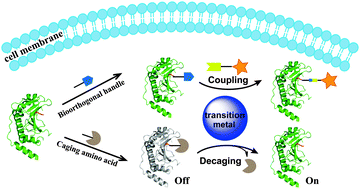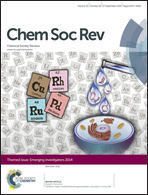Transition metal-mediated bioorthogonal protein chemistry in living cells
Abstract
Considerable attention has been focused on improving the biocompatibility of Cu(I)-catalyzed azide–alkyne cycloaddition (CuAAC), a hallmark of bioorthogonal reaction, in living cells. Besides creating copper-free versions of click chemistry such as strain promoted azide–alkyne cycloaddition (SPAAC), a central effort has also been made to develop various Cu(I) ligands that can prevent the cytotoxicity of Cu(I) ions while accelerating the CuAAC reaction. Meanwhile, additional transition metals such as palladium have been explored as alternative sources to promote a bioorthogonal conjugation reaction on cell surface, as well as within an intracellular environment. Furthermore, transition metal mediated chemical conversions beyond conjugation have also been utilized to manipulate protein activity within living systems. We highlight these emerging examples that significantly enriched our protein chemistry toolkit, which will likely expand our view on the definition and applications of bioorthogonal chemistry.

- This article is part of the themed collections: Celebrating the ChemSocRev Lectureship winners and Chem Soc Rev Emerging Investigators

 Please wait while we load your content...
Please wait while we load your content...